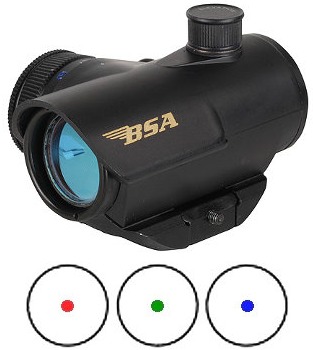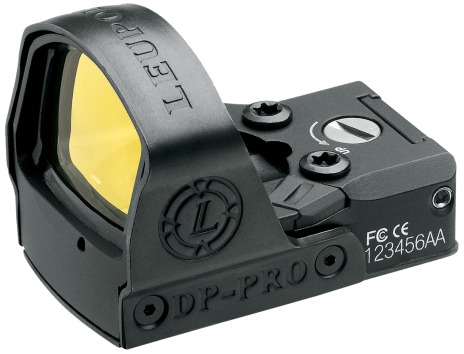|
Red Dot Optical Sights for Hunting Rifles By Chuck Hawks Red dot optical sights typically fall into two categories. There is the kind built into tubes, usually with an objective diameter of 25mm to 40mm. These look like short, fat riflescopes and usually have riflescope-like turret adjustments for windage and elevation. The BSA Huntsman would be an example of this type.  The other type of red dot sight is the reflex sight. In these minimalist sights, the red aiming dot is projected on an open glass, usually held in place by a simple frame. These essentially work like miniature versions of the reflector sights once common in fighter planes. The Leupold DeltaPoint Pro is an example of such a sight. Reflex sights are usually adjusted by set screws, or have coin slot adjustments.  Reflex type sights are completely exposed to the weather, rain and snow. All red dot sights should be waterproof, as they are electronic and water and electronics don't mix, but it is especially important that reflex sights be completely waterproof. The Leupold DeltaPoint Pro shown above is waterproof to 33 feet. Most red dot sights mount to the firearm by means of a Weaver/Picatinny rail. However, some sights use proprietary mounting systems that may not be applicable to most rifles. For use on a rifle, I have generally found the tube type red dot sight faster to acquire. The aiming eye must be closely aligned with the axis of any red dot sight, or the aiming dot disappears. Perhaps counter-intuitively, I find looking through the tube makes this alignment more natural to achieve. Either type of red dot sight can be used with both eyes open and they have extended eye relief, which means an almost unrestricted field of view. This is a real advantage for the woods hunter. However, for the rifleman hunter, most red dot sights come with overly large aiming dots (4 to 8 MOA) that cover too much of the target at 100 yards. Look for a sight with a 3.5 MOA, or preferably smaller, dot. Typical windage and elevation adjustment increments are 1/2 MOA or 1 MOA. Some red dot sights use continuous adjustments (no clicks or increments). Avoid red dot sights with adjustment increments greater than 1 MOA. In addition, note the total available adjustment range. 45 MOA should be adequate for most hunting rifles. The BSA Huntsman sight pictured has 45 MOA of W&E adjustments, while the Leupold DeltaPoint Pro has 60 MOA. Red dot sights are powered by batteries and batteries can fail in cold temperatures, such as fall and winter when most big game hunting is done. Larger batteries usually have better cold temperature performance than small batteries, but require a larger sight to house them. A red dot sight is probably not the best choice for cold weather applications. Red dot optical sights are commonly seen on pistols, AR-15 / Ruger Mini-14 type carbines and tactical shotguns. The aforementioned are all normally viewed as fast response, relatively short range weapons, often chosen for home defense purposes. They are seldom used beyond 100 yards. Maximum field of view and fast target acquisition are more important than precision in most cases. Red dot sights, whether of the tube or reflex (open) type are appropriate for such purposes. They can also work well on slug shooting, hunting shotguns. Red dot sights are, however, seldom encountered on hunting rifles, rimfire or centerfire. As it happens, there are good reasons for this. The problem is, for use on typical deer rifles, without any magnification the red dot does not help you distinguish antlers from branches, or some idiot in a brown coat from the body of a deer, especially in dim light. The former once happened to me, so I missed a chance at a nice 4-point (Western count) buck. The .30-30 cartridge and others in the same general class (.25-35, .32 Win. Special, .35 Remington, etc.) have a maximum point blank range (+/- 3") of over 200 yards and easily out range the capability of a red dot sight, so I would not regard this as a good combination. A 1.5-5x or 2-7x riflescope would be a much more useful match. This is even more true for high intensity hunting cartridges on the order of the .300 Savage, .308 Marlin and .308 Winchester, where a 2-7x or 3-9x riflescope is the way to go. The situation is much the same for .22 rimfire, small game hunting rifles. The range is much shorter, but the target is much smaller and typically found among tree branches, brush or other vegetation. Something around 3x or 4x magnification is required for precise head shots and to avoid hitting intervening branches or twigs. However, there are hunting rifles for which a red dot sight can be appropriate. A red dot sight might be fine on a pistol caliber carbine, such as a .327 Mag., .357 Mag., or .44 Mag. Marlin 1894, Henry Big Boy, etc. These are essentially 100 yard rifles and a good red dot sight should suffice, assuming the hunter has 20/20 vision (corrected or otherwise). A top quality reflex sight, such as the Leupold DeltaPoint Pro, might also serve nicely on a .450 Marlin, .45-70 or .350 Rem. Mag. caliber "guide gun" type carbine. A reflex type sight, being particularly small, light and more accurate than iron sights, might be ideal for this application, as such rifles are intended for personal protection from large, dangerous animals at short range (50 yards or less). Note: Guns and Shooting Online has reviewed a number of red dot sights. See the Scope and Optical Sight Articles and Reviews index page. |